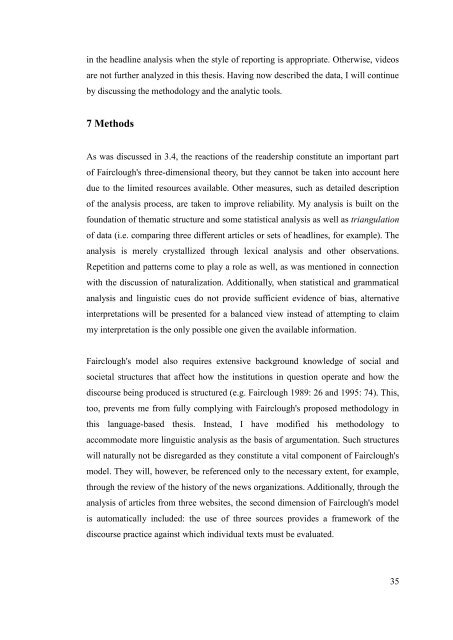Political Bias on BBC, CNN, and Fox News - Doria
Political Bias on BBC, CNN, and Fox News - Doria
Political Bias on BBC, CNN, and Fox News - Doria
Create successful ePaper yourself
Turn your PDF publications into a flip-book with our unique Google optimized e-Paper software.
in the headline analysis when the style of reporting is appropriate. Otherwise, videos<br />
are not further analyzed in this thesis. Having now described the data, I will c<strong>on</strong>tinue<br />
by discussing the methodology <strong>and</strong> the analytic tools.<br />
7 Methods<br />
As was discussed in 3.4, the reacti<strong>on</strong>s of the readership c<strong>on</strong>stitute an important part<br />
of Fairclough's three-dimensi<strong>on</strong>al theory, but they cannot be taken into account here<br />
due to the limited resources available. Other measures, such as detailed descripti<strong>on</strong><br />
of the analysis process, are taken to improve reliability. My analysis is built <strong>on</strong> the<br />
foundati<strong>on</strong> of thematic structure <strong>and</strong> some statistical analysis as well as triangulati<strong>on</strong><br />
of data (i.e. comparing three different articles or sets of headlines, for example). The<br />
analysis is merely crystallized through lexical analysis <strong>and</strong> other observati<strong>on</strong>s.<br />
Repetiti<strong>on</strong> <strong>and</strong> patterns come to play a role as well, as was menti<strong>on</strong>ed in c<strong>on</strong>necti<strong>on</strong><br />
with the discussi<strong>on</strong> of naturalizati<strong>on</strong>. Additi<strong>on</strong>ally, when statistical <strong>and</strong> grammatical<br />
analysis <strong>and</strong> linguistic cues do not provide sufficient evidence of bias, alternative<br />
interpretati<strong>on</strong>s will be presented for a balanced view instead of attempting to claim<br />
my interpretati<strong>on</strong> is the <strong>on</strong>ly possible <strong>on</strong>e given the available informati<strong>on</strong>.<br />
Fairclough's model also requires extensive background knowledge of social <strong>and</strong><br />
societal structures that affect how the instituti<strong>on</strong>s in questi<strong>on</strong> operate <strong>and</strong> how the<br />
discourse being produced is structured (e.g. Fairclough 1989: 26 <strong>and</strong> 1995: 74). This,<br />
too, prevents me from fully complying with Fairclough's proposed methodology in<br />
this language-based thesis. Instead, I have modified his methodology to<br />
accommodate more linguistic analysis as the basis of argumentati<strong>on</strong>. Such structures<br />
will naturally not be disregarded as they c<strong>on</strong>stitute a vital comp<strong>on</strong>ent of Fairclough's<br />
model. They will, however, be referenced <strong>on</strong>ly to the necessary extent, for example,<br />
through the review of the history of the news organizati<strong>on</strong>s. Additi<strong>on</strong>ally, through the<br />
analysis of articles from three websites, the sec<strong>on</strong>d dimensi<strong>on</strong> of Fairclough's model<br />
is automatically included: the use of three sources provides a framework of the<br />
discourse practice against which individual texts must be evaluated.<br />
35

















